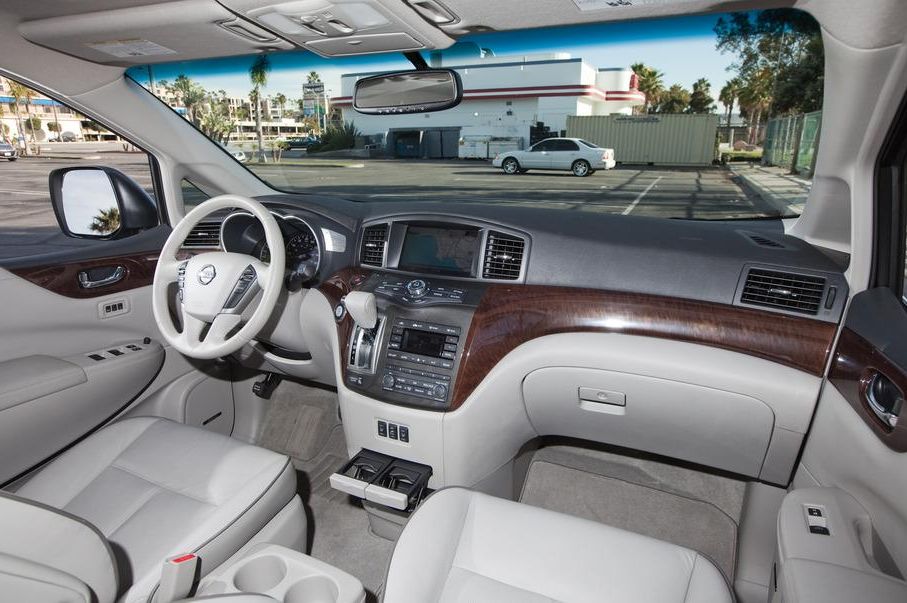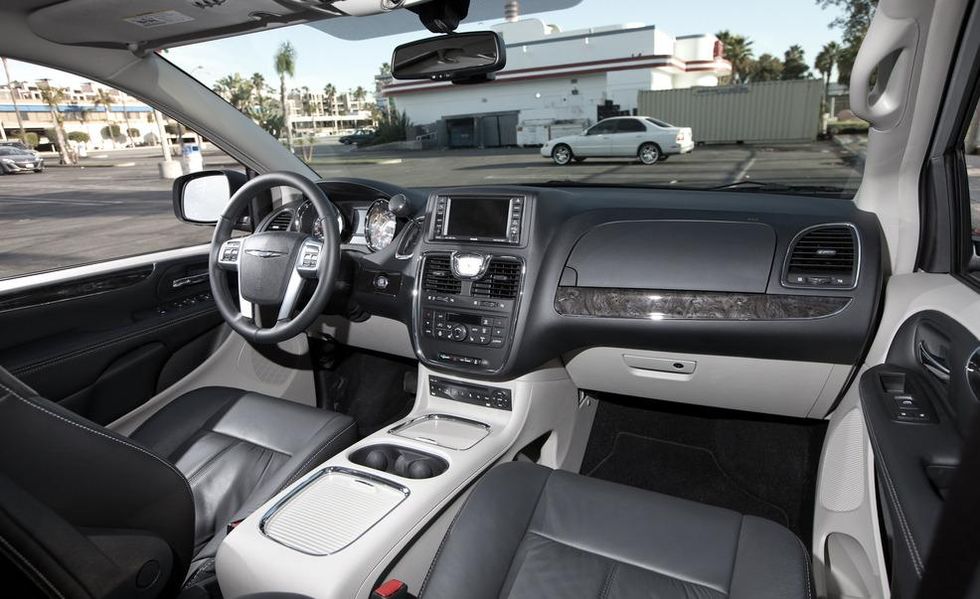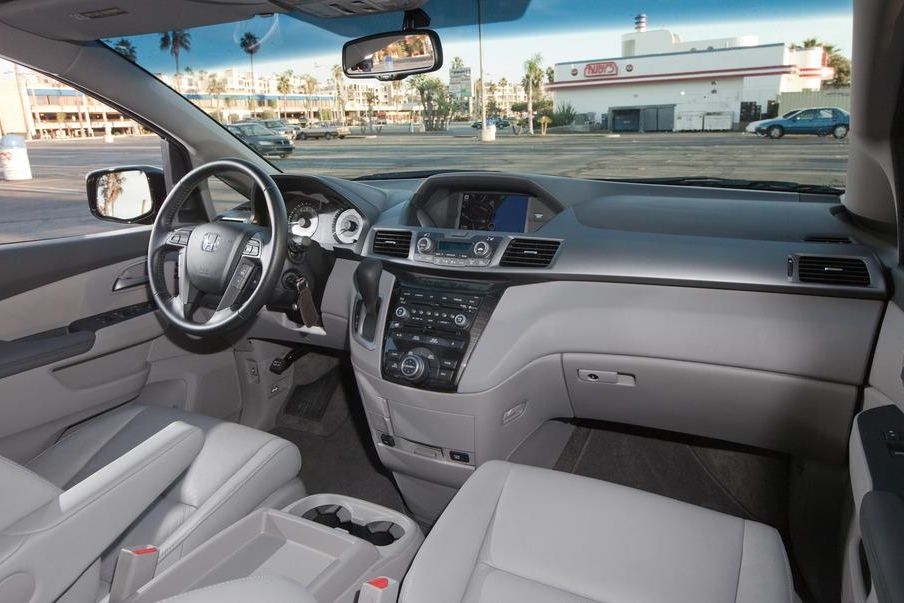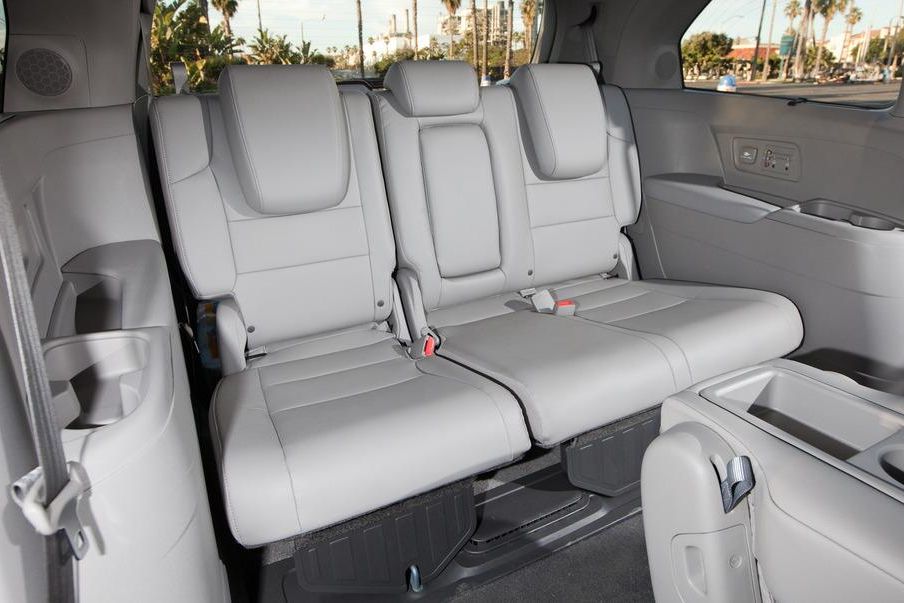2011 Chrysler Town & Country vs. Honda Odyssey, Nissan Quest, Toyota Sienna

From the May 2011 issue of Car and Driver.
Guess what? Minivans are still uncool. Automakers know this. Even the latest ads for the Honda Odyssey and the Toyota Sienna acknowledge the squareness of the segment. Sales have stabilized at about 500,000 units per year since tragically hip moms and dads fled to crossovers. As a mature segment with little potential for growth, minivans are getting comfortable with their squareness. For evidence, we direct your attention to the new Nissan Quest, which not only acknowledges its one-box silhouette but drapes a metaphorical trench coat over the whole thing.
So minivans are cool with being uncool. Can we move on? The premise remains the same as before: Maximize people and cargo space, and forget about the styling. Driving dynamics get second billing. The point is to get you and your kids (or, for aging boomers, your dogs) to and from every destination with the least amount of hassle and the most comfort.
The newest in our assembled quartet is the Nissan Quest, back after a two-year hiatus. Now based on the company’s D platform (shared with the Altima, Maxima, and Murano), the Quest is similar to the Japanese-market Elgrand. For 2011, the Chrysler Town & Country (and its sibling, the Dodge Grand Caravan) gets freshened exterior and interior styling, a retuned suspension, and–most important–a new 283-hp V-6 mated to a six-speed automatic, which replaces all three previous powertrain offerings.
The Odyssey and the Sienna are also new for the 2011 model year, but both offer carry-over engines lashed to new six-speed automatics (available only in Touring trim on the Honda).
There’s a lot of common ground among this set. All four are powered by 24-valve V-6 engines, with only 35 horsepower separating the strongest (Chrysler) from the weakest (Honda). In the top-of-the-line trims we specified for our test group, each minivan comes with power side doors and a power rear hatch. They all offer some sort of flat load floor when the seats are folded and/or removed.
It’s worth noting that although the vans tested here all ring in at about $40,000, each can be had for closer to $30,000. The price of the Sienna, the highest in this test, drops as low as $25,370 for a base four-cylinder model.
In light of the targeted use of these vehicles, we focused on the passenger compartments as much as we did on behind-the-wheel impressions. We watched Team America: World Police multiple times in an effort to evaluate the rear-seat entertainment systems. We also wore a pregnancy-simulation vest while examining each minivan for ease of child-seat installation. And yes, we left some small part of our dignity behind these sliding doors.
4th Place: Toyota Sienna Limited
The Sienna is a perfect example of the—dare we say—pleasures of owning a minivan. A flat, wide floor underneath the driver’s seat makes getting in and out easy. The interior boasts two glove boxes, plus a handy storage cubby on the floor between the instrument panel and the center console in which to store your purse—sorry, “European man-satchel.” The center console deploys rearward to dispatch two cup holders for second-row passengers. And in our Limited model, the second-row residents get captain’s chairs with slide-out leg rests. They even almost work. To fully extend, the second row needs to slide completely back, obliterating third-row leg space. Even then, the leg extensions accommodate only the shorter lower limbs of children. But we like the idea. The same goes for the power-folding third row, which won’t work if the second row is too far aft. We expect better execution from Toyota.
HIGHS: Barcalounger second-row seat, two glove boxes, parking-lot friendly.
LOWS: Cheesy-looking fake wood, light on refinement, bland as a Camry.
VERDICT: Looks great on paper but fails to inspire in person.
A good idea executed poorly also describes the Sienna’s ride, which we deemed too harsh. We commend Toyota for attempting to inject a bit of sportiness into the Sienna, but it seems to have taken things a little too far. Light steering, however, makes for effortless parking-lot navigation, which counts for a lot in this segment. But the power assist doesn’t trail off at driving speeds; as a result, the steering effort stays light, which is at odds with the Sienna’s sporty pretensions.
The Sienna earns points for ergonomics, with easy-to-find buttons for the power doors and the tailgate. The radio and nav system are clustered logically and high on the dash; the climate control has large, legible buttons and is likewise easy to use.
Car and Driver
Kudos also go to the Sienna’s interior space, which is the largest in nearly every category. But with the exception of a best-in-test, 177-foot braking result, the Toyota is at or below average in most performance categories. That backs up our overall impression of the Sienna, which is unremarkable. On paper, everything looks good, but in person and behind the wheel, the Sienna comes off as milquetoast. In that respect, the Sienna is the Camry of minivans. Like its sedan counterpart, it’s not that there is anything wrong with the Sienna—it’s just that it doesn’t make us care about what’s right.
2011 Toyota Sienna Limited
265-hp V-6, 6-speed automatic, 4499 lb
Base/as-tested price: $39,610/$46,782
C/D TEST RESULTS
60 mph: 7.7 sec
1/4 mile: 16.1 sec @ 89 mph
100 mph: 21.0 sec
Braking, 70-0 mph: 177 ft
Roadholding, 300-ft-dia skidpad: 0.79 g
EPA fuel economy, city/highway: 18/24 mpg
3rd Place: Nissan Quest LE
Okay, we did say that minivans are uncool, but the Quest is about as funky as minivans get. We consider the tall, slab-sided exterior and wraparound rear glass a styling success, but then, we also watch Japanese cartoons. Inside, the Quest feels as tall and blocky as it looks outside, and a high cowl restricts forward visibility. But large windows and Dumbo-ear side mirrors mean that vision in every other direction is expansive.
HIGHS: Funky styling, tight turning radius, comfortable front seats.
LOWS: Low-rent center-console plastics, only one 12-volt power port in front.
VERDICT: Not the Holy Grail of minivans but headed in the right direction.
The Quest takes a different approach to seat acrobatics than the other three vans do. Open the rear hatch, and the floor is level with the bumper; cargo stows below a removable panel. The third-row seats fold forward onto the seat cushions, level with the false floor and leaving the rearmost luggage area intact; the other minivans flop the seats backward into the cargo pit. The compromise is a higher load floor—the second-row seats fold and lower themselves to make for a flat cargo area—and less storage space: 19 fewer cubic feet behind the second row and 36 fewer with everything folded versus the next-biggest interior of the Chrysler. If you’re looking to fit Neil Peart’s drum kit into the Quest, you might be short on storage, but we think the ability to fold the third row without moving any cargo will find supporters.
Despite high marks in more advanced subjects, the Quest struggles a bit in Minivan 101. There is only a single 12-volt port in the front of the cabin—the rest have two ports up there. The buttons for the power doors are shaped like Tic Tacs, and our adult fingers had trouble using them. The radio controls are small and situated low on the dash. The front and rear center consoles are made of hard plastic and feature minimalist cup holders that won’t accommodate the larger beverage containers favored by thirsty Americans. Otherwise, the interior looks and feels like an Infiniti’s, with high-gloss wood trim and thoughtful touches such as padded armrests on the front doors. Material quality is top-notch.
We were also impressed with the Quest’s smooth ride, which is almost limo-like. The Nissan’s first-place, 55.6-mph performance in the emergency-lane-change maneuver is more the result of an effective stability-control system that keeps the Quest going where it’s pointed than any handling prowess. Through corners, it feels like the front and rear suspensions were tuned for different vehicles. But going back to minivan priorities, consider the 36.7-foot turning circle, which is slightly better than the Sienna’s, equal to the Odyssey’s, and 2.4 feet tighter than the Chrysler’s.

Car and Driver
Another plus for the Quest is the familiar VQ engine, making 260 horsepower in this application. Unlike the 3.7-liter variant, the 3.5-liter is smooth in the Quest, and the continuously variable automatic responds quickly and without the usual drone we’ve come to expect from these transmissions. Unfortunately, that didn’t translate to quick numbers at the track, where the Quest was slowest to 60 mph. The CVT is also frustrating; it allows the engine to rev for a second when you are pulling into traffic.
Nissan’s return to the minivan market is a solid effort, with high-class material quality, distinctive looks, and a buttery-smooth ride. Only the minor details—which the other automakers have already sorted out—keep it from a higher ranking.
2011 Nissan Quest LE
260-hp V-6, continuously variable, 4508 lb
Base/as-tested price: $42,160/$42,340
C/D TEST RESULTS
60 mph: 7.9 sec
1/4 mile: 16.1 sec @ 91 mph
100 mph: 20.3 sec
Braking, 70-0 mph: 185 ft
Roadholding, 300-ft-dia skidpad: 0.78 g
EPA fuel economy, city/highway: 19/24 mpg
2nd Place: Chrysler Town & Country Limited
In our most recent minivan comparo, we said the Town & Country’s twin, the Dodge Caravan, would have fared better than a third-place finish if it provided its driver a better connection to the road. Clearly, the engineers at Chrysler agreed. Updates for 2011 include a new, stiffer steering rack and retuned shocks and springs. There are also improvements in noise isolation, including better sound-insulating material and improved door seals. The result is a revelation. Gone is the old Town & Country shuffle, in which every shudder echoed through the chassis. The new T&C; is the best-driving minivan of the bunch—rock solid over L.A.’s notoriously undulating freeways, roads that got the best of the Toyota and the Honda. The steering is quick, weighty, and tuned for Turn Nine at Watkins Glen, but we do wonder if the minivan crowd might prefer the lighter steering found in the three other vehicles.
HIGHS: Sporty steering, balanced chassis, high level of refinement.
LOWS: Underwhelming engine power, dowdy exterior styling.
VERDICT: Chrysler fixed everything that was wrong and kept everything that was right.
We’re impressed with the interior updates as well. A couple of caveats: As with the exterior, Chrysler designers followed the maxim of “when in doubt, add chrome,” so there is plenty of—perhaps too much—brightwork outlining the abundant soft-touch plastics. The center console prevents the driver from crawling into the back of the van with any ease. Precocious brats take note: Dad actually will have to park and get out of the van to administer justice, should you fail to knock it off. On the upside, the T&C’s center console has plenty of storage, and the bottom section slides back to reveal second-row cup holders and an additional bin.
Of all the high-end features in the Town & Country—automatic high-beams, remote start, even a heated steering wheel—we found most overrated the $320 luxury second-row seats, which are robust captain’s chairs with a pair of armrests. They’re perfectly comfortable but lack the slick fold-flat feature of the standard Stow ‘n Go second row. The third-row seats can flip backward into a tailgate mode for stationary, rear-facing seating.

Car and Driver
Chrysler’s face lift didn’t fix everything, especially the dowdy exterior. The spongy brake pedal clearly didn’t get the memo sent to the steering, and the T&C’s 70-to-0-mph stopping distance was a last-place 190 feet. The new engine feels good, with much smoother delivery than the instant-on nature of the previous 4.0-liter, but the best power-to-weight ratio yielded only average acceleration. Is it possible that Chrysler’s new Pentastar engine is low on output? Stay tuned.
2011 Chrysler Town & Country Limited
283-hp V-6, 6-speed automatic, 4585 lb
Base/as-tested price: $39,495/$41,085
C/D TEST RESULTS
60 mph: 7.6 sec
1/4 mile: 16.0 sec @ 87 mph
100 mph: 21.9 sec
Braking, 70-0 mph: 190 ft
Roadholding, 300-ft-dia skidpad: 0.80 g
EPA fuel economy, city/highway: 17/25 mpg
1st Place: Honda Odyssey Touring Elite
Give Honda its due: The automaker might be cautious, but it also knows not to fix something that isn’t broken. The Odyssey’s interior is instantly recognizable as a Honda, to the extent that we weren’t exactly sure the cabin was new (it is). Ergonomics reign supreme in this van, with the usual mess of Honda buttons to control the radio and navigation system made tolerable by their large size. The interior employs every spare inch of space for storage, including a second bin in the door just above the map pockets. The Odyssey also features a “cool box” to keep those Odwallas chilled; it’s located between the front seats at the bottom of the dash.
HIGHS: Excellent ergonomics, seating for eight, trick folding third row.
LOWS: Slow and numb steering, contrived exterior styling.
VERDICT: Good for drivers, great for passengers.
Most of the updates, such as the Touring’s six-speed automatic, were similarly well considered. This gearbox earned top marks for its responsiveness and, combined with cylinder deactivation, gives the Odyssey a class-leading 28-mpg EPA highway rating. Some of the credit also goes to Honda’s use of high-strength steel—the Odyssey uses more than any other Honda—which gives it a 135-pound-slimmer curb weight than the next-heaviest minivan in the test, the Toyota. And despite the worst power-to-weight ratio, the Odyssey wins the 0-to-60-mph and quarter-mile sprints, with results of 7.3 and 15.6 seconds, respectively. Not that any of that really matters in this segment. Except that it does—ever try to merge onto the freeway while juggling a tube of Desitin? Then you’ll appreciate the Honda’s lane-owning oomph.
But the Odyssey’s steering—which is a slow, 3.5 turns lock-to-lock and feels dead on-center—could be better. The Honda also exhibits more road noise than we expected (especially after driving the Chrysler), and the ride is choppy over highway expansion joints.

Car and Driver
Where the Odyssey really wins is in versatility. The Honda has two child-seat LATCH (Lower Anchors and Tethers for CHildren) mounts in the third row versus a single position in the other minivans. The Honda also has one more second-row child-seat mount than the rest; it’s the only minivan in the test with a second-row bench seat. The middle position folds down into an armrest proffering three cup holders. That kind of flexibility is what makes the Honda so good, even if second-row buckets give the other vans an air of luxury. The Odyssey’s third row is the most comfortable of the lot, and the easy-fold “magic seat” operation makes us wonder what all the fuss is about with the power-folding nonsense.
The Odyssey provides a detailed picture of the current state of the minivan. Despite a decent styling effort, it still looks uncool. It drives well but not so well that you’ll be tempted to lace up the Alpinestars. But load it up for a weekend and buckle us into one of the rear seats? We’re in. Passengers rule in the minivan, and none treats passengers better
than the Honda.
Lacking any knocked-up staffers in our crew, we foolishly decided we’d try faking it. We called Realityworks (www.realityworks.com), which promptly loaned us a pregnancy profile vest used in prenatal classes and child-development education. With its rib constrictor and a removable bladder (filled with water), the vest simulates the physical discomfort of pregnancy.
Saddled with about 25 additional pounds, we were extra aware of any difficulties presented by getting into and out of the driver’s seat, such as how the Quest requires an extra lurch to settle into the seat. We did find it particularly easy to slide into the Sienna, however.
The Quest also requires careful positioning to get a child seat through the narrow opening of the side doors. In the cabin, however, the Nissan exhibits the most-trouble-free LATCH mounting points. The Sienna’s second-row seats are far more problematic, with padding around the mounting loops that is reluctant to budge. In the Chrysler, fixed second-row headrests make it hard to get a child seat properly aligned.
We were able to shed the pregnancy weight by peeling off a few Velcro straps, but the lingering effects of the vest—lower-back pain, irritability, and a compulsion to straighten everything up—stayed with us for a few hours. Mothers, you have our respect.

Car and Driver
The DVD entertainment system is the vehicular equivalent of a pacifier. The Honda’s screen is wide enough to display two programs side-by-side. So is the Toyota’s. But Honda’s system sounds better and is the only one to offer an HDMI input. Chrysler’s setup gives you two screens, and it’s the only one available with Sirius satellite TV. Nissan’s screen is big, but it can display only one signal at a time. That it pivots open and shut under its own power makes it vulnerable to damage by brats.
2011 Honda Odyssey
248-hp V-6, 6-speed automatic, 4364 lb
Base/as-tested price: $44,030/$44,030
C/D TEST RESULTS
60 mph: 7.3 sec
1/4 mile: 15.6 sec @ 91 mph
100 mph: 19.4 sec
Braking, 70-0 mph: 179 ft
Roadholding, 300-ft-dia skidpad: 0.79 g
EPA fuel economy, city/highway: 19/28 mpg



